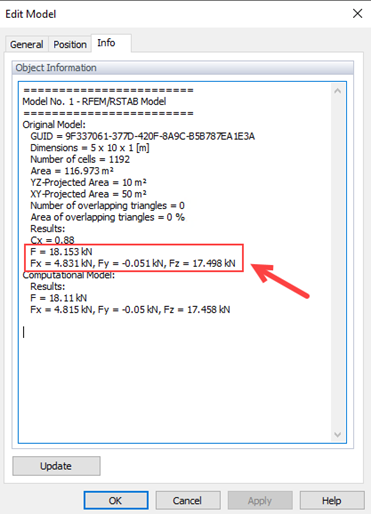User Story
Dans cet exemple, nous allons calculer les valeurs moyennes des forces pour une section de pont, telles qu'applicables aux sections structurelles dans le processus de conception basé sur le WTG-Merkblatt-M3.
Selon la Figure 2.2 dans le WTG-Merkblatt-M3, cet exemple est classé comme Groupe 1.
- G2: Valeurs absolues avec des exigences de précision moyenne. Le domaine d'application peut inclure des paramètres ou des études préliminaires lorsque des investigations ultérieures avec une plus grande précision sont prévues (par exemple, examen en soufflerie de classe G3).
- R2: Solitaires, toutes les directions de vent pertinentes avec une résolution directionnelle suffisamment fine.
- Z1: Valeurs moyennes statistiques, à condition qu'elles concernent des processus d'écoulement stationnaires où les fluctuations (par exemple, dues à la turbulence de l'écoulement approchant) peuvent être capturées suffisamment par d'autres mesures.
- S1: Effets statiques. Il est suffisant de représenter le modèle structurel avec le détail mécanique nécessaire, mais sans propriétés de masse et d'amortissement.
Les dimensions de l'exemple sont montrées dans la Figure 1, et l'hypothèse d'entrée est illustrée dans le Tableau 1 :
Tableau 1 : Données d'entrée de l'exemple de vérification de la section du pont
| Modèle | Section du Pont |
|---|---|
| Vitesse de base du vent | V = 30 m/s |
| Densité de l'air | ρ = 1.225 kg/m³ |
| Solveur | À base de Pression |
| Modèle de Turbulence | k-ω SST Sationnaire |
| Type de profil de vitesse du vent | Constant en hauteur |
| Intensité de la Turbulence | 27% |
| Algorithme numérique | Algorithme SIMPLE |
| Discrétisation | Deuxième Ordre |
| Pression résiduelle | 10⁻⁴ |
| Viscosité cinématique | ν = 1.5 × 10⁻⁵ |
L'Image 2 montre une étude de sensibilité du maillage dans RWIND Pro pour une section de pont. Le coefficient de force 𝐶𝑓
diminue légèrement de 0.94 à 10% de densité de maillage à 0.90 à 25% de densité, puis augmente marginalement à 0.92 à 35% de densité. Bien qu'il y ait une petite fluctuation, la variation reste dans une tolérance acceptable, indiquant que les résultats sont suffisamment stables pour une utilisation pratique en ingénierie.
De plus, l'étude du maillage computationnel doit être effectuée selon le lien suivant :
Dans cet exemple, nous allons comparer la valeur moyenne de la force du vent dans la direction x entre EN 1991-1-4 et RWIND. Le coefficient de force cfx,o pour les sections de pont peut être obtenu en utilisant la Figure 8.3 dans EN 1991-1-4 :
Force dans la Direction X - Méthode Simplifiée
Lorsque l'on a évalué qu'une procédure de réponse dynamique n'est pas nécessaire, la force du vent dans la direction x peut être obtenue en utilisant l'Expression (8.2) dans EN 1991-1-4 :
vb=30 m/s est la vitesse essentielle du vent
C est le facteur de charge du vent. C=ce⋅cf,x=1.425×1.3=1.85, où ce est le facteur d'exposition donné en 4.5 et cf,x est donné en 8.3.1(1)
Aref,x=5 m2 est la zone de référence donnée en 8.3.1
ρ=1.225 kg/m3 est la densité de l'air
Le WTG-Merkblatt M3 propose deux méthodes clés pour valider les résultats de simulation. La méthode dÉvaluation de Taux de Succès évalue combien des valeurs simulées Pi correspondent correctement aux valeurs de référence Oi dans une tolérance définie, en utilisant une approche de classification binaire (succès ou échec). Cette approche évalue la fiabilité de la simulation en calculant un taux de succès q, similaire aux fonctions de confiance utilisées dans la théorie de la fiabilité. En revanche, la méthode de lErreur Quadratique Moyenne Normalisée (e2) offre une évaluation plus détaillée de la précision en quantifiant la déviation quadratique moyenne entre les valeurs simulées et les valeurs de référence, normalisée pour tenir compte des différences d'échelle. Ensemble, ces méthodes fournissent des mesures à la fois qualitatives et quantitatives pour la validation de la simulation.
Résultats de la Force dans RWIND et Comparaison avec l'Eurocode
Dans RWIND, les résultats des forces totales du vent sont disponibles dans l'onglet Info de l'Éditer modèle comme montré dans les Figures 3 et 4. La différence entre le scénario de direction critique du vent RWIND (θ=0°) et l'Eurocode est d'environ Wrel = 5.36% (inférieure au critère mentionné dans le WTG = 10%); alors le taux de succès peut être obtenu comme q=100%, ce qui montre un bon accord. La faible erreur quadratique moyenne normalisée e2=0.002 confirme également un fort accord entre la simulation et les mesures, répondant efficacement aux normes de validation.
.png)



